Pan-Seared Scallops with Lemon Butter
- By Jennifer Segal
- Updated March 20, 2025
- 49 Comments
- Leave a Review


This post may contain affiliate links. Read my full disclosure policy.
Learn to make restaurant-quality scallops at home! Perfectly seared with a golden crust and finished with a bright lemon-butter sauce, they’re simple and downright delicious.
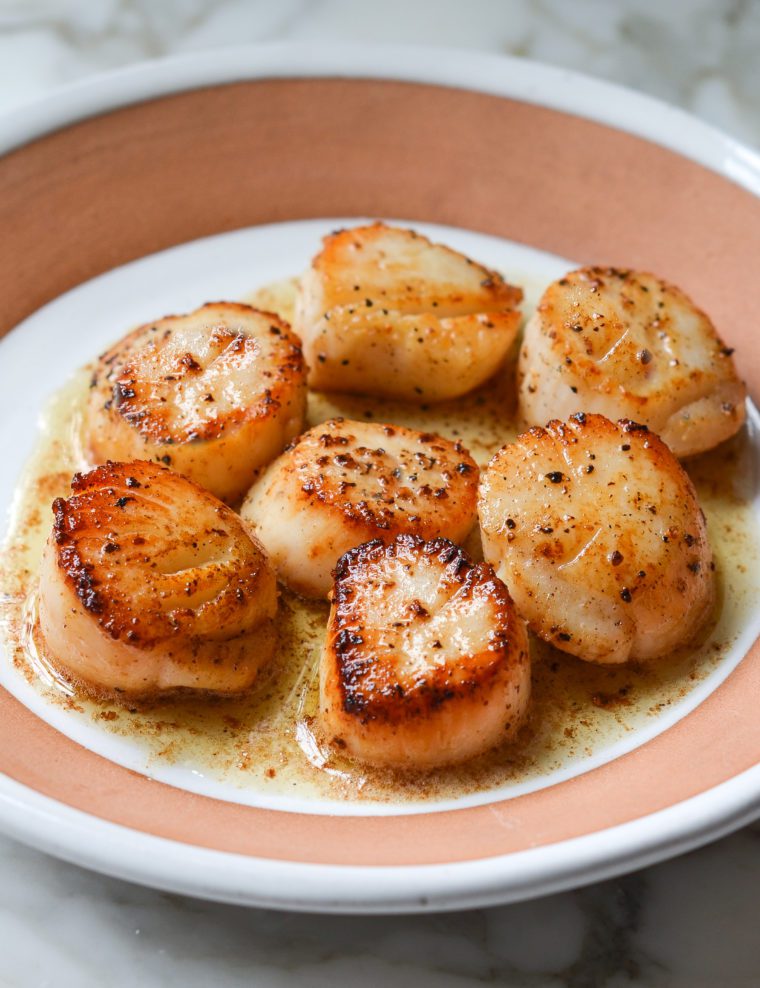
This pan-seared scallops recipe is elegant but surprisingly easy. Like a perfect steak or pan-seared salmon, scallops don’t need fancy sauces or extra ingredients—just the right technique. The trick is to sear them in a very hot pan and resist the urge to fiddle with them as they cook. Let them sit undisturbed, and you’ll be rewarded with a beautifully golden crust and a tender, buttery center.
A simple lemon-butter sauce is all you need to brighten the scallops’ briny sweetness and balance their richness. Want to mix it up? Swap out the lemon for lime, grapefruit, or orange, or toss in some fresh herbs like tarragon, chives, thyme, or basil. This scallops recipe pairs well with risotto or pasta primavera—and don’t forget a crisp white wine to top it all off.
“I made these last night and they turned out perfectly! So simple and quick. The lemon-butter sauce makes these next level.”
What You’ll Need To Make Pan-Seared Scallops Recipe
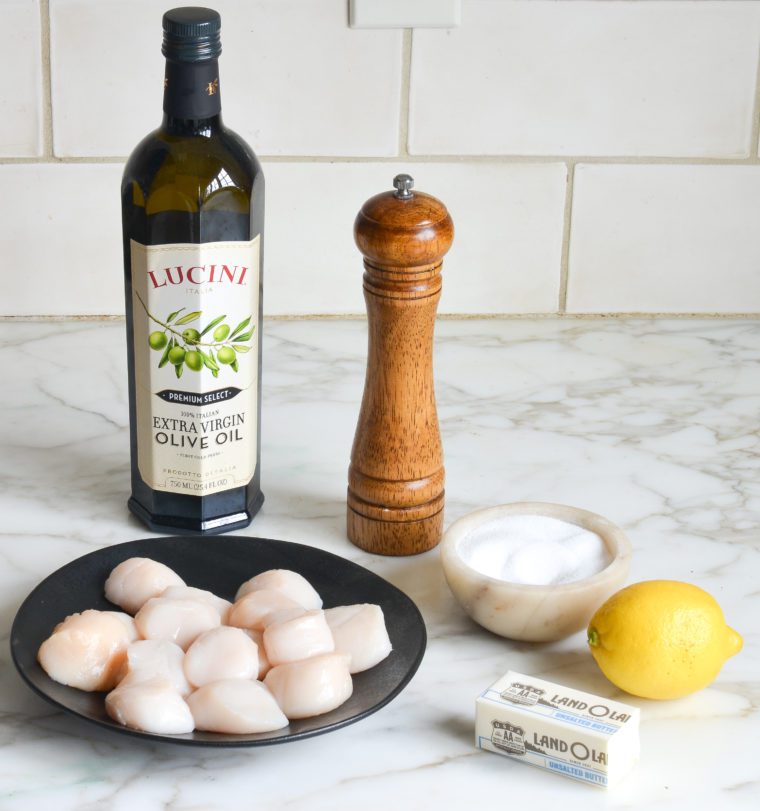
- Dry sea scallops: When purchasing fresh scallops, opt for “dry” or “dry-packed” scallops, as they haven’t been soaked in a solution that causes them to absorb water (avoid “wet scallops”). This ensures they can achieve a golden, caramelized exterior when cooked. Quality seafood markets often carry these but may not label them explicitly, so don’t hesitate to ask your fishmonger for assistance.
- Olive oil: Used in combination with butter for searing. It has a higher smoke point than butter, which prevents burning, and it adds a subtle, fruity flavor to the dish.
- Butter: Adds rich flavor and helps create a beautiful golden crust when searing. It’s also used to finish the dish, adding a silky, luxurious texture to the sauce.
- Lemon juice: Adds brightness and acidity to the dish.
- Jump to the printable recipe for precise measurements
Everything You Need To Know about Scallops
What is the difference between bay scallops and sea scallops?
Bay and sea scallops differ primarily in size and culinary use. Bay scallops are smaller, about the size of a dime, and are often used in casseroles and seafood stews. Sea scallops are larger, with a diameter of up to about 2 inches, and are commonly served in restaurants—they are best for pan-searing.
How can I tell if scallops are fresh?
They should have a mild, briny scent reminiscent of the ocean. If they start to give off a more pronounced fishy smell, it’s an indicator that they’re beginning to spoil. Since they are highly perishable, plan to buy them only a day or two before you intend to cook them.
Do scallops require any prep before cooking?
Some scallops come pre-cleaned, but if not, they have a small muscle on the side, sometimes referred to as the “foot.” I remove it as it can contain sand and toughen when cooked. Simply peel it away from the main body for a clean, pleasant texture. Then, make sure to dry the scallops thoroughly with a paper towel—this step is key for getting that perfect sear.
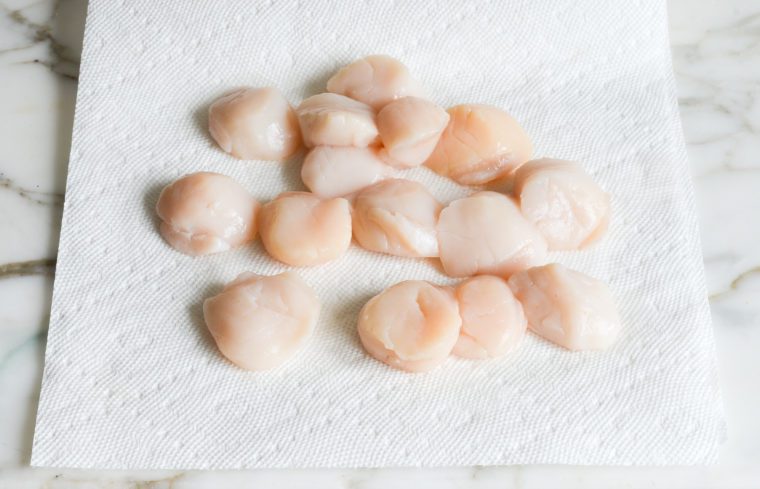
Step-by-Step Instructions For Cooking Scallops
Heat a large skillet (cast iron or a thick-bottomed nonstick pan works best) over medium-high heat until it’s nice and hot. Add the olive oil and butter, swirling to coat the pan. Arrange the scallops in a single layer and season with half of the salt and pepper. Make sure not to crowd the pan!
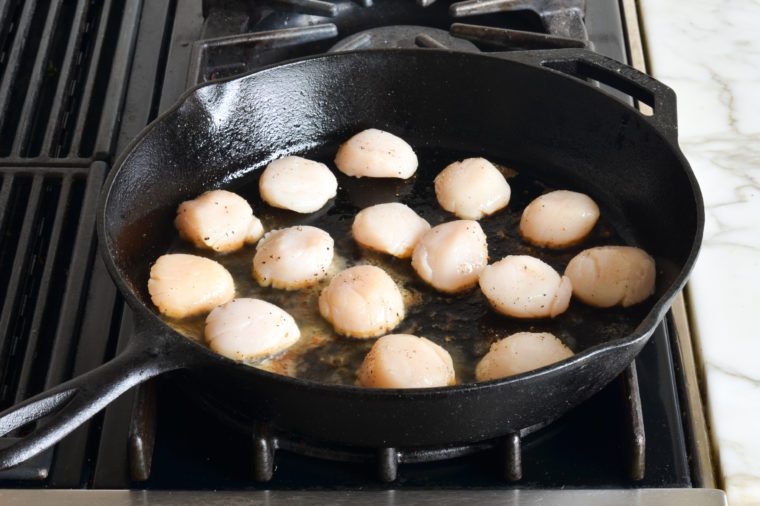
Sear the scallops on the first side for about 3 minutes, without touching or flipping, until they’re golden brown. Then, flip them over, season with the remaining salt and pepper, and sear for another 1 to 2 minutes, until they’re just cooked through.
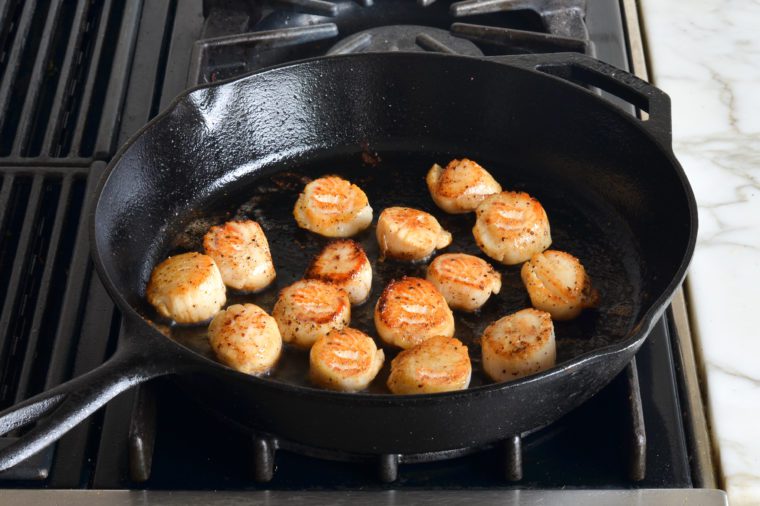
Move the scallops to a plate and remove the pan from the heat. Add the remaining butter to the skillet, then pour in the lemon juice. Swirl the pan a few times, scraping up any browned bits with a wooden spoon to create a quick, flavorful sauce.
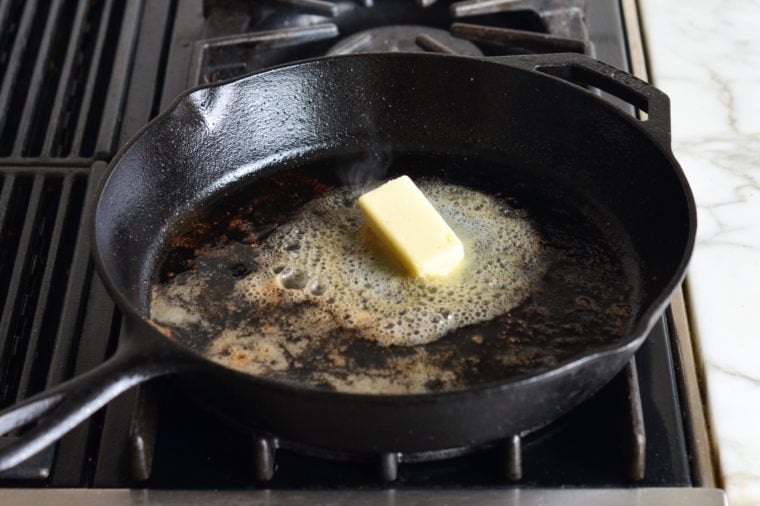
Add the scallops back to the skillet and spoon the sauce over them to warm through. Then, divide the scallops onto 4 plates, making sure to use all the sauce. Garnish with lemon wedges if you’d like!

Scallops Recipe Video Tutorial
More Seafood Recipes You May Like
Pan-Seared Scallops with Lemon Butter

With a gorgeous golden crust and a bright lemon-butter sauce, these scallops make a quick but special dinner that feels restaurant-worthy.
Ingredients
- 12 to 16 dry sea scallops (about ¾ lb; see note)
- 1 tablespoon extra-virgin olive oil
- 4 tablespoons butter, divided
- 1 tablespoon lemon juice
- ¼ teaspoon each salt and freshly ground black pepper
- Lemon wedges, for serving (optional)
Instructions
- Remove the tiny, tough side muscle where sand can hide and rinse the scallops if necessary (some scallops are sold with the muscle already removed). Dry the scallops very well with a paper towel, as moisture can impede browning.
- Heat a large cast iron pan or thick-bottom nonstick sauté pan over medium-high heat until very hot. (Heat two pans if necessary to keep scallops from crowding.) Add the olive oil and ½ tablespoon of the butter, and swirl to coat the pan. Place the scallops in the pan and season with ⅛ teaspoon salt and ⅛ teaspoon pepper. Sear on the first side, without touching or flipping, for about 3 minutes, or until golden. Using tongs, turn the scallops over, season with the remaining ⅛ teaspoon salt and ⅛ teaspoon pepper, and sear for another 1 to 2 minutes, until the scallops are just cooked through.
- Move the scallops to a plate. Remove the pan from the heat and add the remaining 3½ tablespoons butter to the skillet. As the butter is melting, add the lemon juice and swirl the pan a few times, scraping up any browned bits with a wooden spoon.
- Add the scallops back in the skillet, baste with the sauce to warm, and then divide onto 4 plates, using all the sauce. Garnish with lemon wedges, if desired.
- Note: When purchasing scallops, look for the “dry” or “dry-packed” variety. Some scallops on the market are dipped in a solution to extend shelf life. The scallops end up absorbing the water in the solution, increasing the price and causing the scallops to leak moisture when cooked (which will keep them from developing a beautifully caramelized exterior). Quality seafood markets typically carry dry scallops but don’t usually label them; if you're uncertain of what to buy, ask your fishmonger.
- Variation: For even more flavor, you can brown the butter to make a brown butter lemon sauce. Before cooking the scallops, start the sauce by adding 3½ tablespoons of the butter to a small, thick-bottomed saucepan. Bring to a boil, and then simmer on medium heat for 3 to 4 minutes. You will notice foaming and then milk particles will begin to drop to the bottom. When the butter turns golden and starts to smell nutty, it’s done. Set aside for a minute or two. Strain through the finest strainer you have to remove the brown bits. (It’s called “brown butter,” but a key to browning butter is to remove when it is golden, before it paradoxically turns brown and burns.) Set the strained butter aside and proceed with the recipe, adding the browned butter to the pan after cooking the scallops.
Pair with
Nutrition Information
Powered by ![]()
- Per serving (4 servings)
- Serving size: 4 scallops
- Calories: 202
- Fat: 15 g
- Saturated fat: 8 g
- Carbohydrates: 4 g
- Sugar: 0 g
- Fiber: 0 g
- Protein: 12 g
- Sodium: 394 mg
- Cholesterol: 55 mg
This website is written and produced for informational purposes only. I am not a certified nutritionist and the nutritional data on this site has not been evaluated or approved by a nutritionist or the Food and Drug Administration. Nutritional information is offered as a courtesy and should not be construed as a guarantee. The data is calculated through an online nutritional calculator, Edamam.com. Although I do my best to provide accurate nutritional information, these figures should be considered estimates only. Varying factors such as product types or brands purchased, natural fluctuations in fresh produce, and the way ingredients are processed change the effective nutritional information in any given recipe. Furthermore, different online calculators provide different results depending on their own nutrition fact sources and algorithms. To obtain the most accurate nutritional information in a given recipe, you should calculate the nutritional information with the actual ingredients used in your recipe, using your preferred nutrition calculator.
See more recipes:
Comments
Add a Comment Cancel reply
This site uses Akismet to reduce spam. Learn how your comment data is processed.
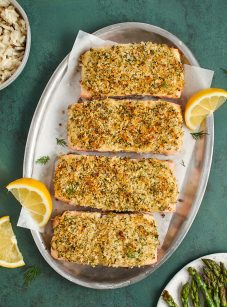
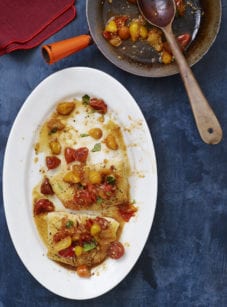
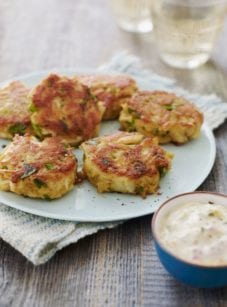
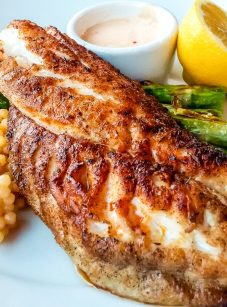

This is such a simple, elegant, dish; featuring my very favorite shellfish. I really appreciated your advice on how to source the scallops themselves, to get the best outcome. I’ve always wanted to make Coquilles St-Jacques at home, especially for a holiday meal; but am not so confident with how to do that well. Have you considered developing a recipe for that dish? I’m thinking of it as an appetizer, but sometimes it’s also the main dish with some luxurious sides.
Glad you enjoyed the scallops, and I’ll add Coquilles St-Jacques to my list of recipes to potentially develop – thanks for the suggestion!
This recipe is simple and perfect! I’ve used it many times!
I made this last night and my family and I loved it! I did not stray from the recipe and it was absolutely delicious!
Thanks Jenn!!!
Hi Jen,
Quick question…
I saw your comment about using dry sea scallops. I do not have easy access to fresh, fresh sea scallops where I live. Are frozen considered wet, and could they be used for pan searing?
Thanks. Love your blog and cookbooks. I have both!
Hi Kelly, so glad you like the recipes and cookbooks! 💜
Not all frozen scallops are wet. To ensure you’re getting dry scallops, look for packaging that indicates the scallops are “dry” or “chemical-free.” If the package doesn’t specify, they are likely wet.
If you can only get wet scallops, pat them really dry, sprinkle a little flour on them, and they will not stick you your pan. As soon as wet scallops hit a hot pan they steam and stick, this fixes that and I found them just a yummy. But I would really prefer dry.
These are as good as any high end restaurant. I use avocado oil, Olive oil is great BUT I think you should NEVER sear or fry with it.
If olive oil is heated beyond its smoke point, it gives off toxic smoke. Because olive oil has a low smoking point, cooking with olive oil runs the risk of creating smoke that contains compounds that are harmful to human health. You may not even notice that you are breathing in this toxic smoke it also changes the taste.The second time I made these I bought wet scallops, I dried them with a towel and sprinkled a little flour on each side, worked great. No madder how high the oil is wet scallops will stick to the bottom of the pan. Alway try and buy dry scallops. I would give it a 5 star but olive is the wrong oil to use. Look up the difference between dry and wet scallops most people do not know.
Oh my goodness!
I wasn’t able to acquire fresh nor dry packed Scallops, only frozen but even so this is so delicious! I placed seared Scallops on a bed of mixed greens used the lemon & butter sauce as my dressing and added feta cheese and mandarin slices and it is the most divine flavors.
Thank you Jenn! As always you are amazing!
I am not a good cook. my husband is a retired chef and restaurant owner and has always done the cooking at home. But he has been recovering from some surgery and I am cooking if you can call it that. LOL! Well this recipe was so easy it will now be my go to. Thanks